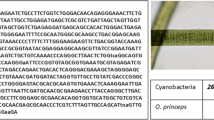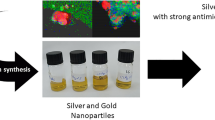Abstract
Biofilms are made up of bacterial colonies and their extracellular polymeric substances (EPS) matrix, which protects the bacteria from adverse environmental conditions. The increasing drug resistivity of pathogenic bacteria is becoming an emergency for developing new antibacterial agents. In this study, we have synthesized the zinc oxide nanoparticles (ZnO NPs) using the leaf extract of Saraca asoca plant, and the antibacterial and antibiofilm activity of green synthesized ZnO NPs was measured against the biofilm-producing bacteria Bacillus subtilis. The disk diffusion data reveals that the zone of inhibition (ZOI) starts at a concentration of 0.5 mg/mL and minimum inhibition concentration (100 µg/mL) and minimum bactericidal concentration (150 µg/mL) values were also evaluated for green synthesized ZnO nanomaterials. Crystal violet test and microscopic examination were used to assess the impact of produced nanoparticles on biofilm development. The findings indicated a nearly 45%, 64%, and 83% suppression of biofilm development at 0.5 × MIC, 0.75 × MIC, and 1 × MIC value, respectively. The biofilm biomass of the preformed or matured biofilms by the ZnO NPs was evaluated to be 68%, 50%, and 33% at concentrations of 0.5 × MIC, 0.75 × MIC, and 1 × MIC which was concentration-dependent. Moreover, flow cytometry results suggest damage to the bacterial cell membrane. The data indicated that the proportion of dead cells increased with NP concentration in comparison to the control. Therefore, it can be concluded that the green synthetic ZnO nanoparticles showed excellent antibacterial and antibiofilm activity against the Bacillus subtilis bacteria that produce biofilms and that they could be a promising substitute agent for the treatment of biofilms and drug-resistant bacteria.








Similar content being viewed by others
Data availability
All data and materials reported in the manuscripts are available.
References
Agarwal S, Jangir LK, Rathore KS et al (2019) Morphology-dependent structural and optical properties of ZnO nanostructures. Appl Phys A Mater Sci Process 125:553. https://doi.org/10.1007/s00339-019-2852-x
Agarwal S, Rai P, Gatell EN et al (2019) Gas sensing properties of ZnO nanostructures (flowers/rods) synthesized by hydrothermal method. Sens Actuators B Chem 292:24–31. https://doi.org/10.1016/j.snb.2019.04.083
Agrawal A, Sharma A, Awasthi KK, Awasthi A (2021) Metal oxides nanocomposite membrane for biofouling mitigation in wastewater treatment. Mater Today Chem 21:100532. https://doi.org/10.1016/j.mtchem.2021.100532
Ambika S, Sundrarajan M (2015) Green biosynthesis of ZnO nanoparticles using Vitex negundo L. extract: Spectroscopic investigation of interaction between ZnO nanoparticles and human serum albumin. J Photochem Photobiol B 149:143–148. https://doi.org/10.1016/J.JPHOTOBIOL.2015.05.004
Awasthi A, Sharma P, Jangir L et al (2020) Dose dependent enhanced antibacterial effects and reduced biofilm activity against Bacillus subtilis in presence of ZnO nanoparticles. Mater Sci Eng: C 113:111021. https://doi.org/10.1016/J.MSEC.2020.111021
Awasthi G, Singh T, Tiwari Y et al (2020) A review on nanotechnological interventions for plant growth and production. Mater Today Proc 31:685–693. https://doi.org/10.1016/J.MATPR.2020.07.255
Banerjee S, Vishakha K, Das S et al (2020) Antibacterial, anti-biofilm activity and mechanism of action of pancreatin doped zinc oxide nanoparticles against methicillin resistant Staphylococcus aureus. Colloids Surf B Biointerfaces 190:110921. https://doi.org/10.1016/j.colsurfb.2020.110921
Basri HH, Talib RA, Sukor R et al (2020) Effect of synthesis temperature on the size of ZnO nanoparticles derived from pineapple peel extract and antibacterial activity of ZnO–starch nanocomposite films. Nanomaterials 10:1061. https://doi.org/10.3390/NANO10061061
Boudarel H, Mathias JD, Blaysat B, Grédiac M (2018) Towards standardized mechanical characterization of microbial biofilms: analysis and critical review. NPJ Biofilms Microbiomes 4:17. https://doi.org/10.1038/s41522-018-0062-5
Chakansin C, Yostaworakul J, Warin C et al (2022) Resazurin rapid screening for antibacterial activities of organic and inorganic nanoparticles: potential, limitations and precautions. Anal Biochem 637:114449. https://doi.org/10.1016/j.ab.2021.114449
Chatzimitakos T, Kallimanis A, Avgeropoulos A, Stalikas CD (2016) Antibacterial, anti-biofouling, and antioxidant prospects of metal-based nanomaterials. Clean (Weinh) 44:794–802. https://doi.org/10.1002/clen.201500366
Chennimalai M, Vijayalakshmi V, Senthil TS, Sivakumar N (2021) One-step green synthesis of ZnO nanoparticles using Opuntia humifus fruit extract and their antibacterial activities. Mater Today: Proc 47:1842–1846. https://doi.org/10.1016/j.matpr.2021.03.409
Demissie MG, Sabir FK, Edossa GD, Gonfa BA (2020) Synthesis of zinc oxide nanoparticles using leaf extract of Lippia adoensis (Koseret) and evaluation of its antibacterial activity. J Chem 2020:9. https://doi.org/10.1155/2020/7459042
Dobrucka R, Długaszewska J (2016) Biosynthesis and antibacterial activity of ZnO nanoparticles using Trifolium pratense flower extract. Saudi J Biol Sci 23:517–523. https://doi.org/10.1016/J.SJBS.2015.05.016
Donlan RM (2001) Biofilm formation: a clinically relevant microbiological process. Clin Infect Dis 8:1387–1392. https://doi.org/10.1086/322972
Elshikh M, Ahmed S, Funston S et al (2016) Resazurin-based 96-well plate microdilution method for the determination of minimum inhibitory concentration of biosurfactants. Biotechnol Lett 38:1015–1019. https://doi.org/10.1007/s10529-016-2079-2
Flemming HC (2020) Biofouling and me: my Stockholm syndrome with biofilms. Water Res 173:115576. https://doi.org/10.1016/j.watres.2020.115576
Garrett TR, Bhakoo M, Zhang Z (2008) Bacterial adhesion and biofilms on surfaces. Prog Natur Sci 18(9):1049–1056. https://doi.org/10.1016/j.pnsc.2008.04.001
Gnanamozhi P, Renganathan V, Chen SM et al (2020) Influence of nickel concentration on the photocatalytic dye degradation (methylene blue and reactive red 120) and antibacterial activity of ZnO nanoparticles. Ceram Int. https://doi.org/10.1016/j.ceramint.2020.05.054
Gupta M, Sasmal S, Mukherjee A (2014) Therapeutic effects of acetone extract of Saraca asoca seeds on rats with adjuvant-induced arthritis via attenuating inflammatory responses. ISRN Rheumatol 2014:12. https://doi.org/10.1155/2014/959687
Hajipour MJ, Fromm KM, Akbar Ashkarran A et al (2012) Antibacterial properties of nanoparticles. Trends Biotechnol 30(10):499–511. https://doi.org/10.1016/j.tibtech.2012.06.004
Ifeanyichukwu UL, Fayemi OE, Ateba CN (2020) Green synthesis of zinc oxide nanoparticles from pomegranate (punica granatum) extracts and characterization of their antibacterial activity. Molecules 25(19):4521. https://doi.org/10.3390/molecules25194521
Iqbal Y, Raouf Malik A, Iqbal T et al (2021) Green synthesis of ZnO and Ag-doped ZnO nanoparticles using Azadirachta indica leaves: characterization and their potential antibacterial, antidiabetic, and wound-healing activities. Mater Lett 305:130671. https://doi.org/10.1016/j.matlet.2021.130671
Jiang W, Mashayekhi H, Xing B (2009) Bacterial toxicity comparison between nano- and micro-scaled oxide particles. Environ Pollut 157:1619–1625. https://doi.org/10.1016/j.envpol.2008.12.025
Jiang Y, Zhang L, Wen D, Ding Y (2016) Role of physical and chemical interactions in the antibacterial behavior of ZnO nanoparticles against E. coli. Mater Sci Eng: C 69:1361–1366. https://doi.org/10.1016/J.MSEC.2016.08.044
Kumar S, Awasthi K, Mishra YK (2021) Synthesis of ZnO nanostructures. Nanostruct Zinc Oxide 93–116. https://doi.org/10.1016/B978-0-12-818900-9.00016-4
Kumar Jangir L, Kumari Y, Kumar A et al (2017) Investigation of luminescence and structural properties of ZnO nanoparticles{,} synthesized with different precursors. Mater Chem Front 1:1413–1421. https://doi.org/10.1039/C7QM00058H
López D, Vlamakis H, Kolter R (2010) Biofilms. Cold Spring Harb Perspect Biol 2:a000398. https://doi.org/10.1101/CSHPERSPECT.A000398
MalligArjuna Rao S, Kotteeswaran S, Visagamani AM (2021) Green synthesis of zinc oxide nanoparticles from camellia sinensis: organic dye degradation and antibacterial activity. Inorg Chem Commun 134:108956. https://doi.org/10.1016/J.INOCHE.2021.108956
Manna AC (2012) Synthesis, characterization, and antimicrobial activity of zinc oxide nanoparticles. In: Nano-Antimicrobials: Progress and Prospects. Springer, Berlin Heidelberg, pp 151–180. https://doi.org/10.1007/978-3-642-24428-5_5
Natarajan S, Bhuvaneshwari M, Lakshmi DS et al (2016) Antibacterial and antifouling activities of chitosan/TiO2/Ag NPs nanocomposite films against packaged drinking water bacterial isolates. Environ Sci Pollut Res 23:19529–19540. https://doi.org/10.1007/s11356-016-7102-6
Nazir A, Akbar A, Baghdadi HB et al (2021) Zinc oxide nanoparticles fabrication using Eriobotrya japonica leaves extract: photocatalytic performance and antibacterial activity evaluation. Arab J Chem 14:103251. https://doi.org/10.1016/j.arabjc.2021.103251
Owais Mushtaq S, Sharma R, Agrawal A et al (2022) Green synthesis of ZnO nanoparticles from saffron corm extract and their bactericidal activity. Mater Today Proc 69:74–81. https://doi.org/10.1016/J.MATPR.2022.09.613
Raghavendra VB, Shankar S, Govindappa M et al (2022) Green synthesis of zinc oxide nanoparticles (ZnO NPs) for effective degradation of dye, polyethylene and antibacterial performance in waste water treatment. J Inorg Organomet Polym Mater 32:614–630. https://doi.org/10.1007/s10904-021-02142-7
Rasli NI, Basri H, Harun Z (2020) Zinc oxide from aloe vera extract: two-level factorial screening of biosynthesis parameters. Heliyon 6:e03156. https://doi.org/10.1016/J.HELIYON.2020.E03156
Roy R, Tiwari M, Donelli G, Tiwari V (2018) Strategies for combating bacterial biofilms: a focus on anti-biofilm agents and their mechanisms of action. Virulence 9(1):522–554. https://doi.org/10.1080/21505594.2017.1313372
Samreen Ahmad I, Malak HA, Abulreesh HH (2021) Environmental antimicrobial resistance and its drivers: a potential threat to public health. J Glob Antimicrob Resist 27:101–111. https://doi.org/10.1016/j.jgar.2021.08.001
Santhoshkumar J, Kumar SV, Rajeshkumar S (2017) Synthesis of zinc oxide nanoparticles using plant leaf extract against urinary tract infection pathogen. Resour-Efficient Technol 3:459–465. https://doi.org/10.1016/J.REFFIT.2017.05.001
Schachter B (2003) Slimy business - The biotechnology of biofilms. Nat Biotechnol 21:361–365. https://doi.org/10.1038/nbt0403-361
Sharma P, Bhati VS, Kumar M et al (2020) Development of ZnO nanostructure film for pH sensing application. Appl Phys A 126:284. https://doi.org/10.1007/s00339-020-03466-w
Sharma R, Agrawal A, Sharma A et al (2022) Effect of biosynthesized ZnO nanoparticles on wheat seedlings. Mater Today Proc. https://doi.org/10.1016/j.matpr.2022.08.353
Sharma A, Agrawal A, Kumar S, et al (2021) Zinc oxide nanostructures–based biosensors. In: Nanostructured Zinc Oxide. Elsevier, pp 655–695. https://doi.org/10.1016/B978-0-12-818900-9.00002-4
Sheikh M, Pazirofteh M, Dehghani M et al (2020) Application of ZnO nanostructures in ceramic and polymeric membranes for water and wastewater technologies: a review. Chem Eng J 391:123475. https://doi.org/10.1016/j.cej.2019.123475
Shetti NP, Bukkitgar SD, Reddy KR et al (2019) ZnO-based nanostructured electrodes for electrochemical sensors and biosensors in biomedical applications. Biosens Bioelectron 141:111417. https://doi.org/10.1016/j.bios.2019.111417
Tam KH, Djurišić AB, Chan CMN et al (2008) Antibacterial activity of ZnO nanorods prepared by a hydrothermal method. Thin Solid Films 516:6167–6174. https://doi.org/10.1016/J.TSF.2007.11.081
Tayel AA, El-Tras WF, Moussa S et al (2011) Antibacterial action of zinc oxide nanoparticles against foodborne pathogens. J Food Saf 31:211–218. https://doi.org/10.1111/J.1745-4565.2010.00287.X
Yu H, Liu Y, Li L et al (2020) Ultrasound-involved emerging strategies for controlling foodborne microbial biofilms. Trends Food Sci Technol 96:91–101. https://doi.org/10.1016/j.tifs.2019.12.010
Zhang L, Jiang Y, Ding Y et al (2007) Investigation into the antibacterial behaviour of suspensions of ZnO nanoparticles (ZnO nanofluids). J Nanopart Res. https://doi.org/10.1007/s11051-006-9150-1
Acknowledgements
The authors acknowledge Materials Research Centre, MNIT Jaipur for providing the characterization facilities.
Funding
Council for Scientific and Industrial Research, Govt. of India, and IUAC, New Delhi [UFR 66323] provided financial support.
Author information
Authors and Affiliations
Contributions
All authors have contributed to the study conception and design Ankush Agrawal: material preparation, data collection and analysis, writing manuscript. Ruhani Sharma: data collection, formal analysis, writing manuscript. Ankita Sharma: data collection, formal analysis. Kailash Chand Gurjar: visualization and editing, Sanjay Kumar: data collection and analysis, writing manuscript. Samit Chatterjee: formal analysis and editing, Harsh Pandey: formal analysis and editing, Kamlendra Awasthi: conceptualization and editing. Anjali Awasthi: conceptualization, experimental designing, supervision and editing. All authors read and approved the final manuscript.
Corresponding author
Ethics declarations
Ethics approval
N/A.
Consent to participate
Authors have given their consent to publish the manuscript.
Consent for publication
All authors have approved the manuscript for publication.
Competing interests
The authors declare no competing interests.
Additional information
Responsible Editor: Diane Purchase
Publisher's note
Springer Nature remains neutral with regard to jurisdictional claims in published maps and institutional affiliations.
Rights and permissions
Springer Nature or its licensor (e.g. a society or other partner) holds exclusive rights to this article under a publishing agreement with the author(s) or other rightsholder(s); author self-archiving of the accepted manuscript version of this article is solely governed by the terms of such publishing agreement and applicable law.
About this article
Cite this article
Agrawal, A., Sharma, R., Sharma, A. et al. Antibacterial and antibiofilm efficacy of green synthesized ZnO nanoparticles using Saraca asoca leaves. Environ Sci Pollut Res 30, 86328–86337 (2023). https://doi.org/10.1007/s11356-023-28524-7
Received:
Accepted:
Published:
Issue Date:
DOI: https://doi.org/10.1007/s11356-023-28524-7




